Tuesday, June 24, 2014 9:06:45 AM
The Nearly Mile-Wide Diamond Mine That Helped Build the Soviet Union

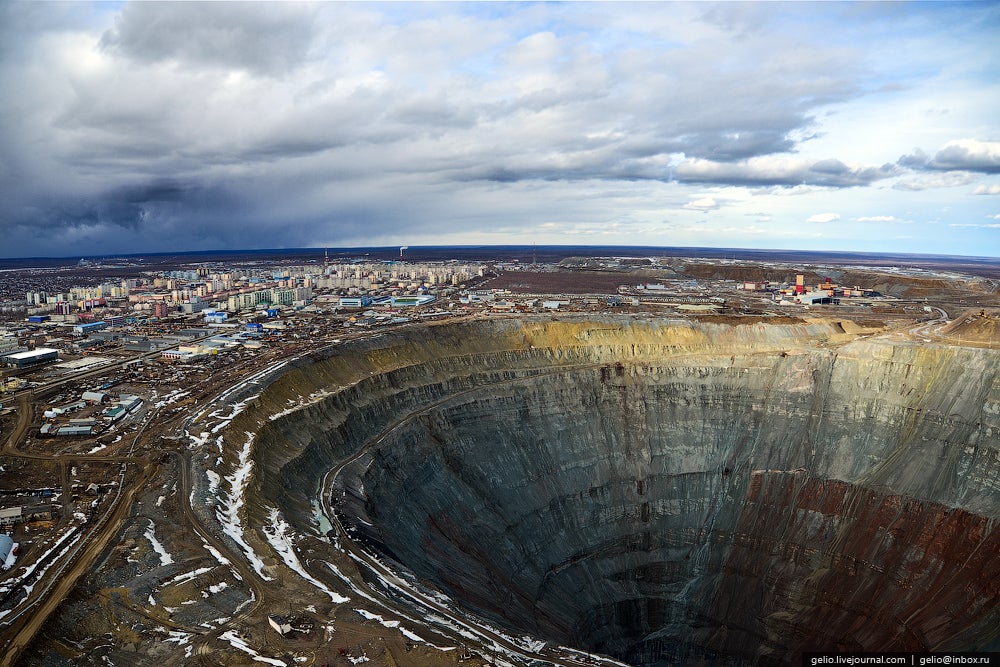
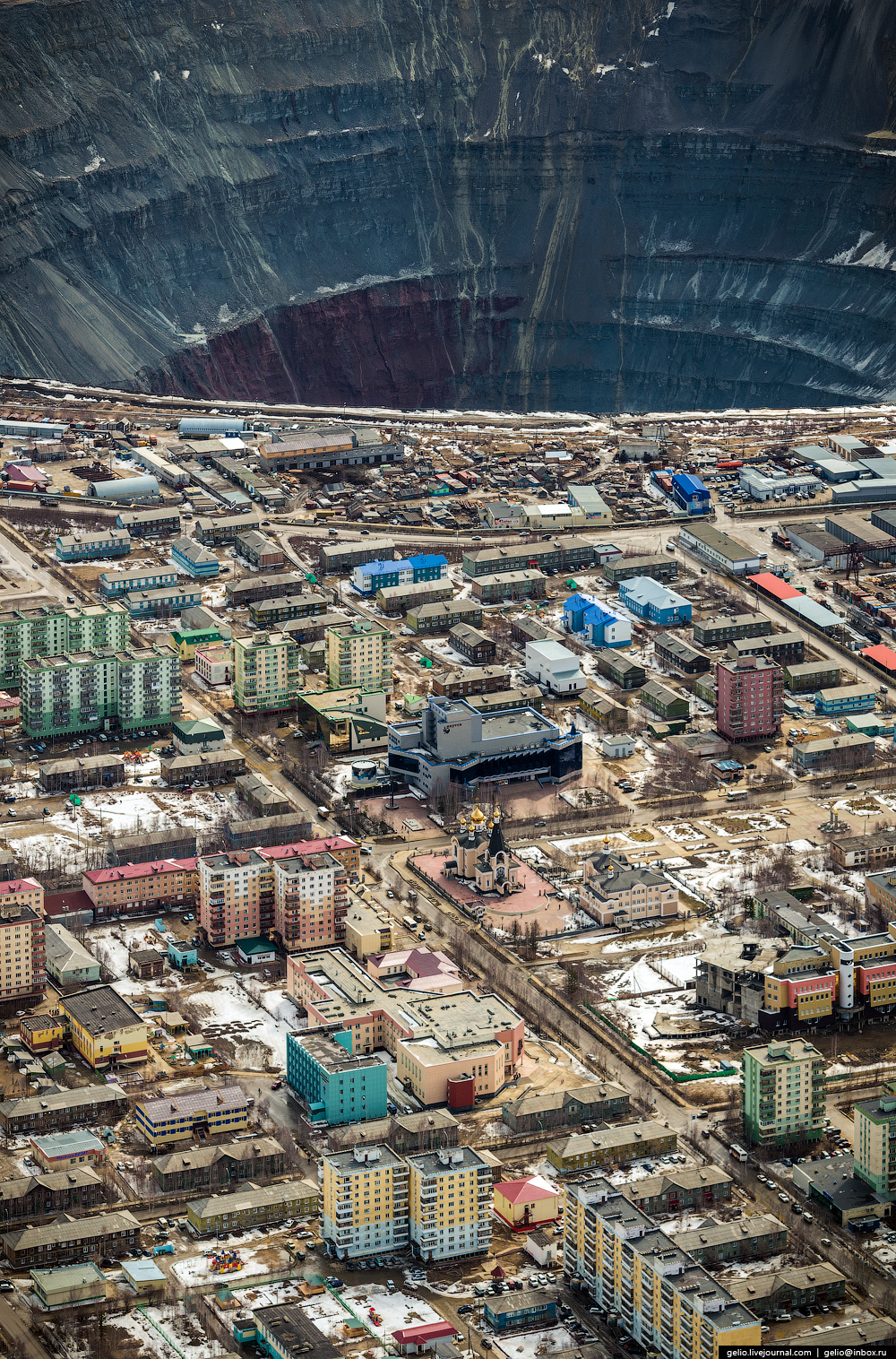

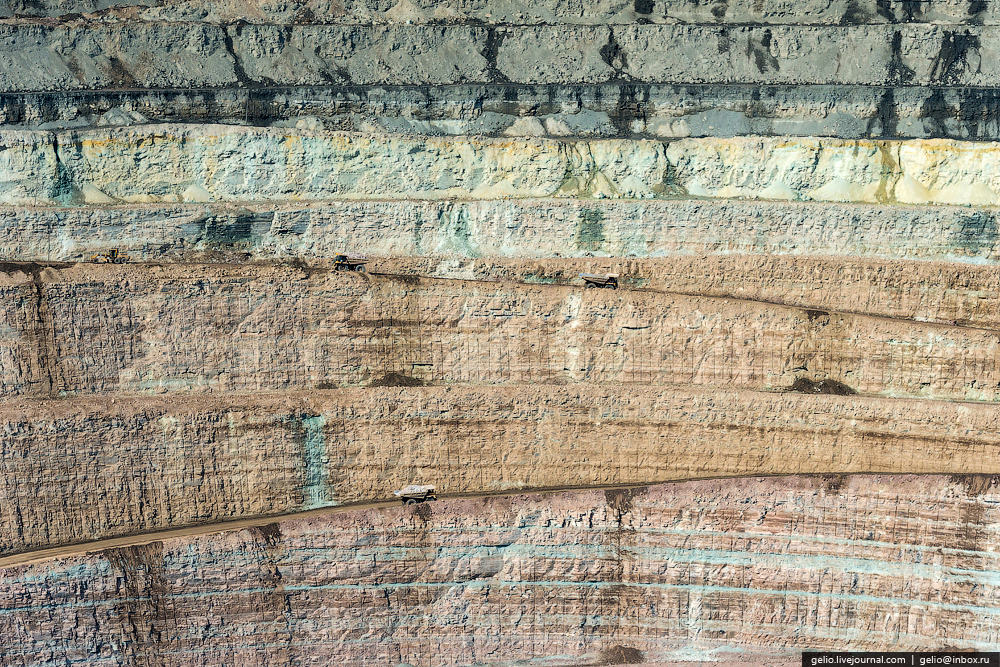
June 20, 2014
[more at/via] http://gizmodo.com/the-nearly-mile-wide-diamond-mine-that-helped-build-the-1593234924 [with comments]
--
The World's Second Largest Hole
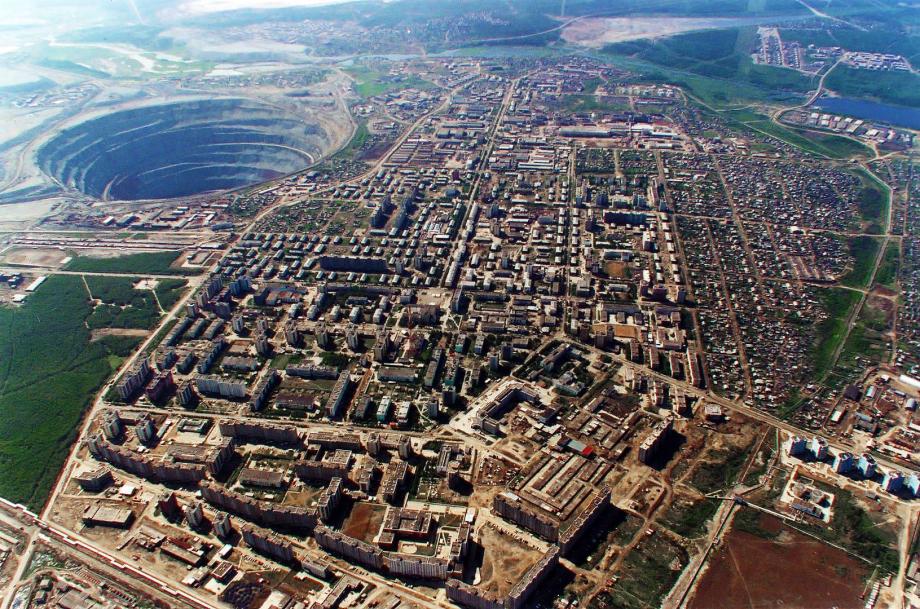
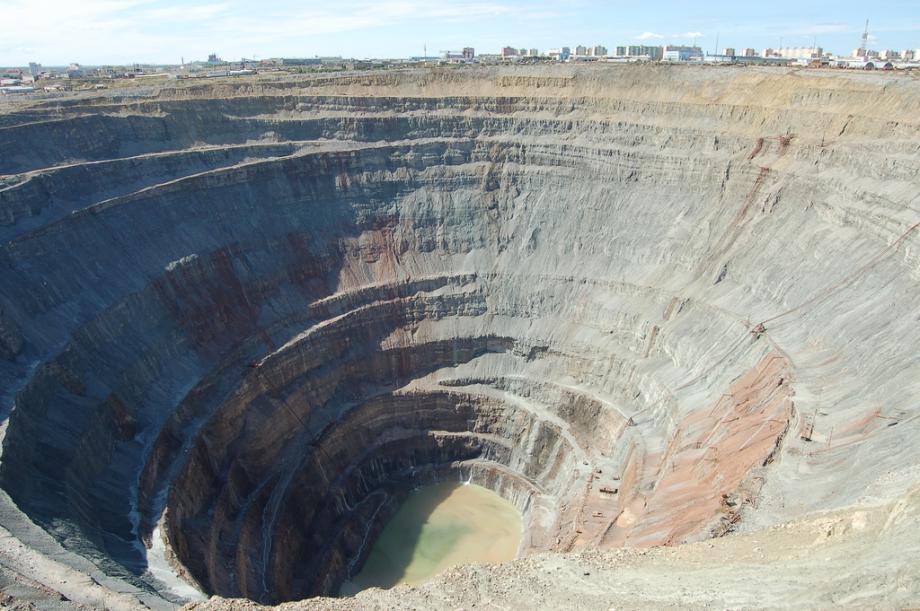
June 28 2013
[more at/via] http://www.slate.com/blogs/atlas_obscura/2013/06/28/russian_diamond_mine_is_the_worlds_second_largest_hole.html [no comments yet]
===
“World's largest man made hole in the ground!”

Bingham mine 5-10-03
[ http://en.wikipedia.org/wiki/Bingham_Canyon_Mine ]
samscholes
Salt Lake City, Utah
Reviewed February 11, 2013
Where else in the world can you go to see a hole in the ground large enough to be visible from outer-space? Well I am here to tell you, nowhere!
Kennecott Utah Copper's Bingham Canyon Mine has been in production since 1906, and has resulted in a open-pit mine that is over 0.75 miles deep and 2.5 miles wide! The mine itself covers an area of more then 1900 acres and according to Kennecott, it is the world's largest man-made excavation! Those are some pretty impressive figures for a big hole in the ground.
Visiting Bingham Canyon Mine is very interesting and well worth your time. The on-site visitor center provides a great history of mining in the area, discusses the relevance and value of mining in our everyday lives, and has lots of interesting historical photos and artifacts to check out. Everyday we use products that are the products of mines around the world--the computers we use, our phones, our soaps, toothpastes and shampoos. In fact, chances are good that the majority of the products in your home or office were once dug out of a mine.
If you haven't seen the world's largest man made hole in the ground, you need to go!
Visited April 2012
http://www.tripadvisor.com/ShowUserReviews-g56934-d591647-r151857611-Bingham_Canyon_Mine-Bingham_Canyon_Utah.html
--
Mine Landslide Triggered Quakes

The April 10, 2013, landslide at Rio Tinto-Kennecott Utah Copper’s Bingham Canyon mine contains enough debris to bury New York City’s Central Park 66 feet deep, according to a new University of Utah study. The slide happened in the form of two rock avalanches 95 minutes apart. The first rock avalanche included grayer bedrock material seen around the margins of the lower half of the slide. The second rock avalanche is orange in color, both from bedrock and from waste rock from mining. The new study found the landslide triggered 16 small quakes. Such triggering has not been noted previously. The slide likely was the largest nonvolcanic landslide in North America’s modern history.

This spectrogram of a seismic recording shows four peaks in red and orange. The first, wider peak represents the low rumbling of the second rock avalanche in the massive Bingham Canyon Mine landslide in Utah on April 10, 2013. The three sharper peaks are from three of the small earthquakes that were triggered by the slide, which likely was the largest nonvolcanic landslide in modern North American history.
Click here [ http://unews.utah.edu/wp-content/uploads/event2_fast-1.wav ] to listen to low-frequency rumbling from the second rock avalanche in the April 10, 2013, Bingham Canyon Mine landslide in Utah, followed by three sharp, higher-frequency “shots” from three of the small earthquakes triggered by the slide. This 10-second audio file is from about five minutes of seismic recordings sped up 30 times to bring it into a frequency range people can hear. The spectrogram image above shows the same sounds visually in the form of peaks in a seismic recording.
Record-Breaking Slide Would Bury Central Park 66 Feet Deep
Jan. 6, 2014
http://unews.utah.edu/news_releases/mine-landslide-triggered-quakes/ ; referenced study at http://www.geosociety.org/gsatoday/archive/24/1/article/i1052-5173-24-1-4.htm , and discussed at http://www.e-mj.com/features/4108-recovering-from-bingham-canyon-s-record-setting-2013-slide.html#.U6lNxGcnK5O
===
Take A Trip To This Horrifying Mine, One Of The Largest Man-Made Holes In The World
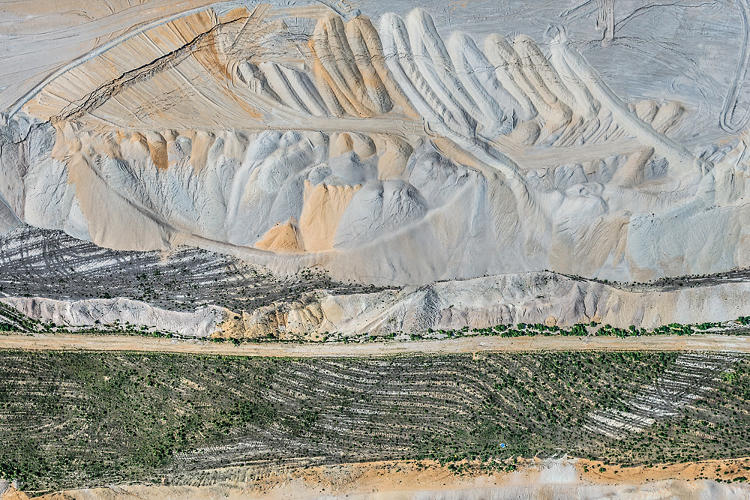
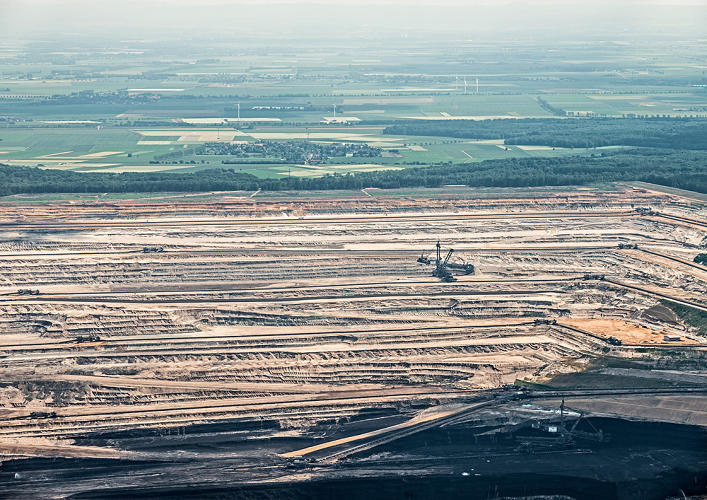
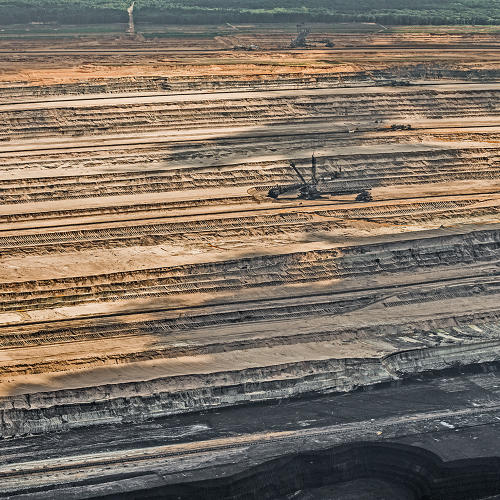
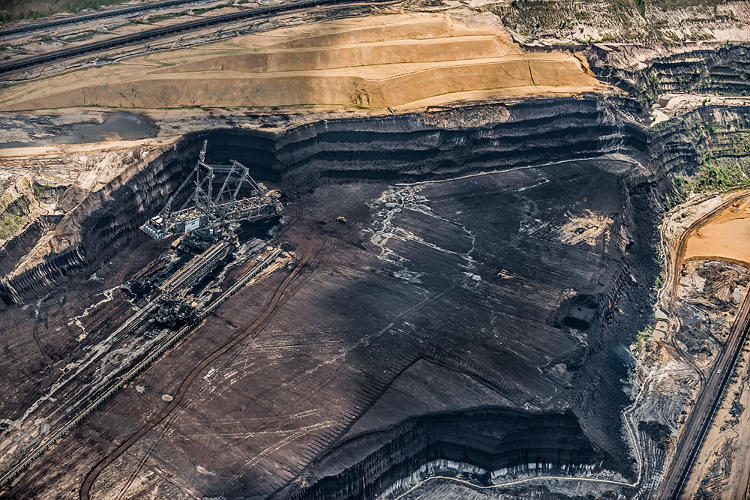
The largest hole in Europe is an open-pit [lignite/brown] coal mine in Germany, and everything inside is just enormous, including machines that are the length of two soccer fields and the height of a 30-story building.
June 20, 2014
[more at/via] http://www.fastcoexist.com/3031997/take-a-trip-to-this-horrifying-mine-one-of-the-largest-man-made-holes-in-the-world [with comments]
===
An anthropogenic marker horizon in the future rock record
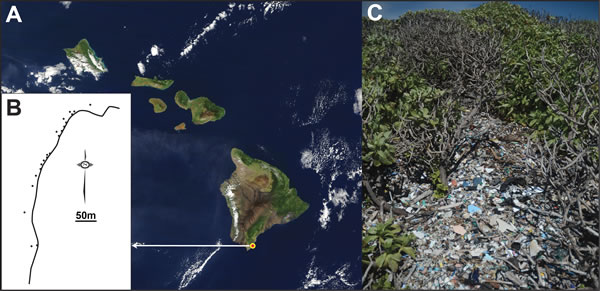
Figure 1
Location and characteristics of Kamilo Beach. (A) Location of Kamilo Beach along the southeast shore of the island of Hawaii (satellite image of 13 Dec. 2002, available at visibleearth.nasa.gov). (B) Sampling locations along the Kamilo Beach shoreline (Pacific Ocean east of the dark line). (C) Plastic “confetti” trapped within vegetation.
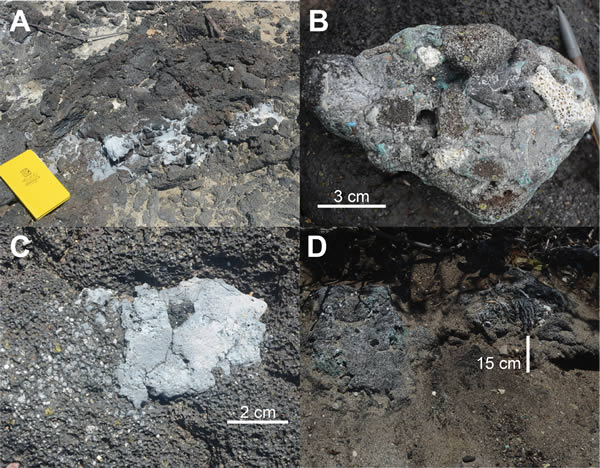
Figure 2
Characteristics of the two types of plastiglomerate. (A) In situ plastiglomerate wherein molten plastic is adhered to the surface of a basalt flow. Field book is 18 cm long. (B) Clastic plastiglomerate containing molten plastic and basalt and coral fragments. (C) Plastic amygdales in a basalt flow. (D) Large in situ plastiglomerate fragment. Adhered molten plastic was found 15 cm below the surface. Note the protected vegetated location.
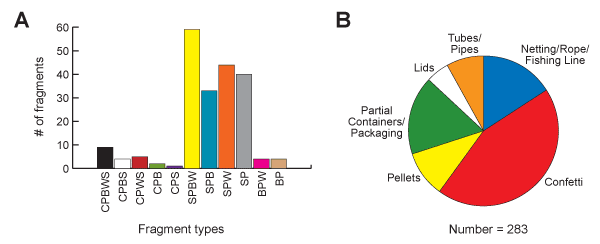
Figure 3
Diagrams illustrating the types of plastiglomerate and relative percentages of adhered plastic fragments. (A) Material composing the sampled plastiglomerate: B—basalt clasts; C—coral fragments; P—plastic; S—sand and sand-size shelly fragments; W—woody debris. (B) Pie diagram showing the relative abundance of different plastic products in plastiglomerate.
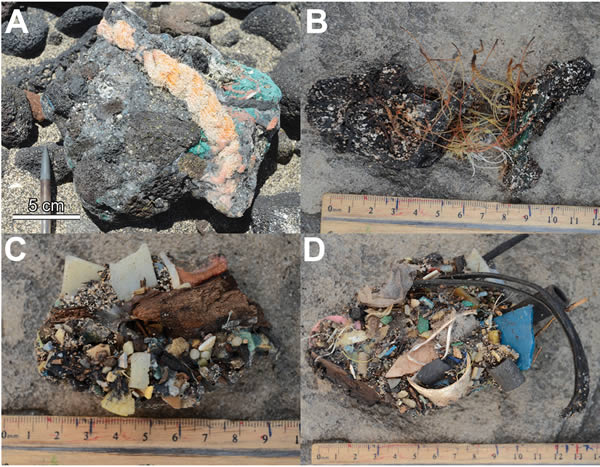
Figure 4
Photographs of clastic plastiglomerate on Kamilo Beach. (A) Subrounded fragment containing basalt clasts, molten plastic, yellow rope, and green and red netting. (B) Portions of black and green plastic containers adhered to basalt fragments and connected by netting. (C) Fragment containing plastic pellets and “confetti” with woody debris. (D) Adhered mixture of sand, black tubing, a bottle lid, “confetti,” netting, and part of a plastic bag.
GSA Today
Volume 24 Issue 6 (June 2014)
Article, pp. 4-8
ABSTRACT
Recognition of increasing plastic debris pollution over the last several decades has led to investigations of the imminent dangers posed to marine organisms and their ecosystems, but very little is known about the preservation potential of plastics in the rock record. As anthropogenically derived materials, plastics are astonishingly abundant in oceans, seas, and lakes, where they accumulate at or near the water surface, on lake and ocean bottoms, and along shorelines. The burial potential of plastic debris is chiefly dependent on the material’s density and abundance, in addition to the depositional environment. Here, we report the appearance of a new “stone” formed through intermingling of melted plastic, beach sediment, basaltic lava fragments, and organic debris from Kamilo Beach on the island of Hawaii. The material, herein referred to as “plastiglomerate,” is divided into in situ and clastic types that were distributed over all areas of the beach. Agglutination of natural sediments to melted plastic during campfire burning has increased the overall density of plastiglomerate, which inhibits transport by wind or water, thereby increasing the potential for burial and subsequent preservation. Our results indicate that this anthropogenically influenced material has great potential to form a marker horizon of human pollution, signaling the occurrence of the informal Anthropocene epoch.
[study in full at] http://www.geosociety.org/gsatoday/archive/24/6/article/i1052-5173-24-6-4.htm
--
Are we now living in the Anthropocene?
GSA Today
v. 18, no. 2, FEBRUARY 2008
ABSTRACT
The term Anthropocene, proposed and increasingly employed
to denote the current interval of anthropogenic global environmental
change, may be discussed on stratigraphic grounds. A
case can be made for its consideration as a formal epoch in that,
since the start of the Industrial Revolution, Earth has endured
changes sufficient to leave a global stratigraphic signature distinct
from that of the Holocene or of previous Pleistocene interglacial
phases, encompassing novel biotic, sedimentary, and
geochemical change. These changes, although likely only in
their initial phases, are sufficiently distinct and robustly established
for suggestions of a Holocene–Anthropocene boundary
in the recent historical past to be geologically reasonable.
The boundary may be defined either via Global Stratigraphic
Section and Point (“golden spike”) locations or by adopting a
numerical date. Formal adoption of this term in the near future
will largely depend on its utility, particularly to earth scientists
working on late Holocene successions. This datum, from the
perspective of the far future, will most probably approximate a
distinctive stratigraphic boundary.
[study in full at] http://www.geosociety.org/gsatoday/archive/18/2/pdf/i1052-5173-18-2-4.pdf [specifically further to/the study referenced in/see (linked in) http://investorshub.advfn.com/boards/read_msg.aspx?message_id=30821328 and preceding and following (along with the other related linkings grouped with that one at the end of the post to which this is a reply)]
===
in addition to (linked in) the post to which this is a reply and preceding and (other) following, see also (linked in):
http://investorshub.advfn.com/boards/read_msg.aspx?message_id=50054530 (and any future following)
http://investorshub.advfn.com/boards/read_msg.aspx?message_id=77610668 and preceding and following
http://investorshub.advfn.com/boards/read_msg.aspx?message_id=77869081 and preceding and following
http://investorshub.advfn.com/boards/read_msg.aspx?message_id=77970515 and preceding and following
http://investorshub.advfn.com/boards/read_msg.aspx?message_id=78687954 and preceding and following
http://investorshub.advfn.com/boards/read_msg.aspx?message_id=81786501 and preceding and following
http://investorshub.advfn.com/boards/read_msg.aspx?message_id=83696920 and preceding and following,
http://investorshub.advfn.com/boards/read_msg.aspx?message_id=97993043 and preceding (and any future following),
http://investorshub.advfn.com/boards/read_msg.aspx?message_id=102380749 and preceding and following,
http://investorshub.advfn.com/boards/read_msg.aspx?message_id=102389177 (and any future following)
http://investorshub.advfn.com/boards/read_msg.aspx?message_id=83966251 and preceding and following
http://investorshub.advfn.com/boards/read_msg.aspx?message_id=85219643 and following
http://investorshub.advfn.com/boards/read_msg.aspx?message_id=85743065 (and any future following)
http://investorshub.advfn.com/boards/read_msg.aspx?message_id=91324070 and following
http://investorshub.advfn.com/boards/read_msg.aspx?message_id=95024177 and preceding and following
http://investorshub.advfn.com/boards/read_msg.aspx?message_id=97212285 and preceding and following
http://investorshub.advfn.com/boards/read_msg.aspx?message_id=97470612 and following
http://investorshub.advfn.com/boards/read_msg.aspx?message_id=102389231 and preceding and following
http://investorshub.advfn.com/boards/read_msg.aspx?message_id=102456111 and preceding and following
http://investorshub.advfn.com/boards/read_msg.aspx?message_id=102798621 and preceding and following
http://investorshub.advfn.com/boards/read_msg.aspx?message_id=103628151 and preceding (and any future following)
http://investorshub.advfn.com/boards/read_msg.aspx?message_id=103631292 and preceding (and any future following)





June 20, 2014
[more at/via] http://gizmodo.com/the-nearly-mile-wide-diamond-mine-that-helped-build-the-1593234924 [with comments]
--
The World's Second Largest Hole


June 28 2013
[more at/via] http://www.slate.com/blogs/atlas_obscura/2013/06/28/russian_diamond_mine_is_the_worlds_second_largest_hole.html [no comments yet]
===
“World's largest man made hole in the ground!”

Bingham mine 5-10-03
[ http://en.wikipedia.org/wiki/Bingham_Canyon_Mine ]
samscholes
Salt Lake City, Utah
Reviewed February 11, 2013
Where else in the world can you go to see a hole in the ground large enough to be visible from outer-space? Well I am here to tell you, nowhere!
Kennecott Utah Copper's Bingham Canyon Mine has been in production since 1906, and has resulted in a open-pit mine that is over 0.75 miles deep and 2.5 miles wide! The mine itself covers an area of more then 1900 acres and according to Kennecott, it is the world's largest man-made excavation! Those are some pretty impressive figures for a big hole in the ground.
Visiting Bingham Canyon Mine is very interesting and well worth your time. The on-site visitor center provides a great history of mining in the area, discusses the relevance and value of mining in our everyday lives, and has lots of interesting historical photos and artifacts to check out. Everyday we use products that are the products of mines around the world--the computers we use, our phones, our soaps, toothpastes and shampoos. In fact, chances are good that the majority of the products in your home or office were once dug out of a mine.
If you haven't seen the world's largest man made hole in the ground, you need to go!
Visited April 2012
http://www.tripadvisor.com/ShowUserReviews-g56934-d591647-r151857611-Bingham_Canyon_Mine-Bingham_Canyon_Utah.html
--
Mine Landslide Triggered Quakes

The April 10, 2013, landslide at Rio Tinto-Kennecott Utah Copper’s Bingham Canyon mine contains enough debris to bury New York City’s Central Park 66 feet deep, according to a new University of Utah study. The slide happened in the form of two rock avalanches 95 minutes apart. The first rock avalanche included grayer bedrock material seen around the margins of the lower half of the slide. The second rock avalanche is orange in color, both from bedrock and from waste rock from mining. The new study found the landslide triggered 16 small quakes. Such triggering has not been noted previously. The slide likely was the largest nonvolcanic landslide in North America’s modern history.

This spectrogram of a seismic recording shows four peaks in red and orange. The first, wider peak represents the low rumbling of the second rock avalanche in the massive Bingham Canyon Mine landslide in Utah on April 10, 2013. The three sharper peaks are from three of the small earthquakes that were triggered by the slide, which likely was the largest nonvolcanic landslide in modern North American history.
Click here [ http://unews.utah.edu/wp-content/uploads/event2_fast-1.wav ] to listen to low-frequency rumbling from the second rock avalanche in the April 10, 2013, Bingham Canyon Mine landslide in Utah, followed by three sharp, higher-frequency “shots” from three of the small earthquakes triggered by the slide. This 10-second audio file is from about five minutes of seismic recordings sped up 30 times to bring it into a frequency range people can hear. The spectrogram image above shows the same sounds visually in the form of peaks in a seismic recording.
Record-Breaking Slide Would Bury Central Park 66 Feet Deep
Jan. 6, 2014
http://unews.utah.edu/news_releases/mine-landslide-triggered-quakes/ ; referenced study at http://www.geosociety.org/gsatoday/archive/24/1/article/i1052-5173-24-1-4.htm , and discussed at http://www.e-mj.com/features/4108-recovering-from-bingham-canyon-s-record-setting-2013-slide.html#.U6lNxGcnK5O
===
Take A Trip To This Horrifying Mine, One Of The Largest Man-Made Holes In The World




The largest hole in Europe is an open-pit [lignite/brown] coal mine in Germany, and everything inside is just enormous, including machines that are the length of two soccer fields and the height of a 30-story building.
June 20, 2014
[more at/via] http://www.fastcoexist.com/3031997/take-a-trip-to-this-horrifying-mine-one-of-the-largest-man-made-holes-in-the-world [with comments]
===
An anthropogenic marker horizon in the future rock record

Figure 1
Location and characteristics of Kamilo Beach. (A) Location of Kamilo Beach along the southeast shore of the island of Hawaii (satellite image of 13 Dec. 2002, available at visibleearth.nasa.gov). (B) Sampling locations along the Kamilo Beach shoreline (Pacific Ocean east of the dark line). (C) Plastic “confetti” trapped within vegetation.

Figure 2
Characteristics of the two types of plastiglomerate. (A) In situ plastiglomerate wherein molten plastic is adhered to the surface of a basalt flow. Field book is 18 cm long. (B) Clastic plastiglomerate containing molten plastic and basalt and coral fragments. (C) Plastic amygdales in a basalt flow. (D) Large in situ plastiglomerate fragment. Adhered molten plastic was found 15 cm below the surface. Note the protected vegetated location.

Figure 3
Diagrams illustrating the types of plastiglomerate and relative percentages of adhered plastic fragments. (A) Material composing the sampled plastiglomerate: B—basalt clasts; C—coral fragments; P—plastic; S—sand and sand-size shelly fragments; W—woody debris. (B) Pie diagram showing the relative abundance of different plastic products in plastiglomerate.

Figure 4
Photographs of clastic plastiglomerate on Kamilo Beach. (A) Subrounded fragment containing basalt clasts, molten plastic, yellow rope, and green and red netting. (B) Portions of black and green plastic containers adhered to basalt fragments and connected by netting. (C) Fragment containing plastic pellets and “confetti” with woody debris. (D) Adhered mixture of sand, black tubing, a bottle lid, “confetti,” netting, and part of a plastic bag.
GSA Today
Volume 24 Issue 6 (June 2014)
Article, pp. 4-8
ABSTRACT
Recognition of increasing plastic debris pollution over the last several decades has led to investigations of the imminent dangers posed to marine organisms and their ecosystems, but very little is known about the preservation potential of plastics in the rock record. As anthropogenically derived materials, plastics are astonishingly abundant in oceans, seas, and lakes, where they accumulate at or near the water surface, on lake and ocean bottoms, and along shorelines. The burial potential of plastic debris is chiefly dependent on the material’s density and abundance, in addition to the depositional environment. Here, we report the appearance of a new “stone” formed through intermingling of melted plastic, beach sediment, basaltic lava fragments, and organic debris from Kamilo Beach on the island of Hawaii. The material, herein referred to as “plastiglomerate,” is divided into in situ and clastic types that were distributed over all areas of the beach. Agglutination of natural sediments to melted plastic during campfire burning has increased the overall density of plastiglomerate, which inhibits transport by wind or water, thereby increasing the potential for burial and subsequent preservation. Our results indicate that this anthropogenically influenced material has great potential to form a marker horizon of human pollution, signaling the occurrence of the informal Anthropocene epoch.
[study in full at] http://www.geosociety.org/gsatoday/archive/24/6/article/i1052-5173-24-6-4.htm
--
Are we now living in the Anthropocene?
GSA Today
v. 18, no. 2, FEBRUARY 2008
ABSTRACT
The term Anthropocene, proposed and increasingly employed
to denote the current interval of anthropogenic global environmental
change, may be discussed on stratigraphic grounds. A
case can be made for its consideration as a formal epoch in that,
since the start of the Industrial Revolution, Earth has endured
changes sufficient to leave a global stratigraphic signature distinct
from that of the Holocene or of previous Pleistocene interglacial
phases, encompassing novel biotic, sedimentary, and
geochemical change. These changes, although likely only in
their initial phases, are sufficiently distinct and robustly established
for suggestions of a Holocene–Anthropocene boundary
in the recent historical past to be geologically reasonable.
The boundary may be defined either via Global Stratigraphic
Section and Point (“golden spike”) locations or by adopting a
numerical date. Formal adoption of this term in the near future
will largely depend on its utility, particularly to earth scientists
working on late Holocene successions. This datum, from the
perspective of the far future, will most probably approximate a
distinctive stratigraphic boundary.
[study in full at] http://www.geosociety.org/gsatoday/archive/18/2/pdf/i1052-5173-18-2-4.pdf [specifically further to/the study referenced in/see (linked in) http://investorshub.advfn.com/boards/read_msg.aspx?message_id=30821328 and preceding and following (along with the other related linkings grouped with that one at the end of the post to which this is a reply)]
===
in addition to (linked in) the post to which this is a reply and preceding and (other) following, see also (linked in):
http://investorshub.advfn.com/boards/read_msg.aspx?message_id=50054530 (and any future following)
http://investorshub.advfn.com/boards/read_msg.aspx?message_id=77610668 and preceding and following
http://investorshub.advfn.com/boards/read_msg.aspx?message_id=77869081 and preceding and following
http://investorshub.advfn.com/boards/read_msg.aspx?message_id=77970515 and preceding and following
http://investorshub.advfn.com/boards/read_msg.aspx?message_id=78687954 and preceding and following
http://investorshub.advfn.com/boards/read_msg.aspx?message_id=81786501 and preceding and following
http://investorshub.advfn.com/boards/read_msg.aspx?message_id=83696920 and preceding and following,
http://investorshub.advfn.com/boards/read_msg.aspx?message_id=97993043 and preceding (and any future following),
http://investorshub.advfn.com/boards/read_msg.aspx?message_id=102380749 and preceding and following,
http://investorshub.advfn.com/boards/read_msg.aspx?message_id=102389177 (and any future following)
http://investorshub.advfn.com/boards/read_msg.aspx?message_id=83966251 and preceding and following
http://investorshub.advfn.com/boards/read_msg.aspx?message_id=85219643 and following
http://investorshub.advfn.com/boards/read_msg.aspx?message_id=85743065 (and any future following)
http://investorshub.advfn.com/boards/read_msg.aspx?message_id=91324070 and following
http://investorshub.advfn.com/boards/read_msg.aspx?message_id=95024177 and preceding and following
http://investorshub.advfn.com/boards/read_msg.aspx?message_id=97212285 and preceding and following
http://investorshub.advfn.com/boards/read_msg.aspx?message_id=97470612 and following
http://investorshub.advfn.com/boards/read_msg.aspx?message_id=102389231 and preceding and following
http://investorshub.advfn.com/boards/read_msg.aspx?message_id=102456111 and preceding and following
http://investorshub.advfn.com/boards/read_msg.aspx?message_id=102798621 and preceding and following
http://investorshub.advfn.com/boards/read_msg.aspx?message_id=103628151 and preceding (and any future following)
http://investorshub.advfn.com/boards/read_msg.aspx?message_id=103631292 and preceding (and any future following)
Join the InvestorsHub Community
Register for free to join our community of investors and share your ideas. You will also get access to streaming quotes, interactive charts, trades, portfolio, live options flow and more tools.










